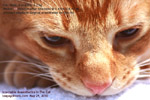SHARING KNOWLEDGE ON INJECTABLE
ANAESTHESIA IN THE STERILISATION
OF CATS AT
TOAPAYOHVETS, SINGAPORE - PART
1
Frequently Asked Questions For Dr
Sing
1.
Best time to spay my female cat?
If cats are home-based and not
permitted to stray outdoors, it is
best to spay at 6 months of age as
their private parts (vulva) will
be able to develop into adult
size.
2.
Best time to neuter my male cats?
I advise 6 months of age. However,
if there is a male and female
sibling cats living in the same
apartment, the male will be much
interested in the female at 6
months of age. Get them sterilised
when interest is shown or neuter
the male at 5 months.
One case study
Two domestic short haired
cats were adopted as
kittens.
At 6 months of age, the male
was very interested in the
female cat at 6 months.
During sterilisation, the
female cat's ovaries were
enlarged and blood vessels
were very red and big,
indicating the cat was on
heat. However she was not
pregnant. The owner stopped
water and food at 10 pm the
previous night. One website
and some vets say that cats
can still be given water
prior to surgery. I don't
agree with this. |
3.
What anaesthesia I use in the
sterilisation of cats in Toa Payoh
Vets for the past 5 years.
I find the following
combination in one syringe given
by IM safe and effective
 INJECTABLE
ANAESTHETICS IM INJECTABLE
ANAESTHETICS IM
General guideline at Toa
Payoh Vets for xylazine +
ketamine IM anaesthesia in
domestic cats, with
isoflurane gas top up if
necessary:
1. The
combination dosage is not
dependent on weight
directly.
2. It is given for a range
of weights as follows:
4-5 kg cat - xylazine 0.2 +
ketamine 0.8 ml IM in one
syringe for a cat spay
without the need to top up
isoflurane gas.
2-4 kg cat - xylazine 0.15 +
ketamine 0.6 ml IM in one
syringe for a cat spay
without the need to top up
isoflurane gas. |
For cat neuter, the dosage
can be reduced. For example,
2-4 kg cat neuter, xylazine
0.1 + ketamine 0.4 ml IM in
one syringe can be
effective.
Surgery is to be done around
5-10 minutes after the
injection. No delays,
otherwise top up with
isoflurane gas is necessary.
|
 |
 |
|
INJECTABLE ANAESTHESIA IM
Male cat, 6 months, 4.2 kg
Xylazine 2% @ 0.15ml + Ketamine
0.6 ml IM
Surgery: 10 minutes after
injection.
Excellent surgical anaesthesia
Neuter 10 minutes after injection
to get the best surgical
anaesthetic effect
Female cat, 6 months, 3.0 kg
Xylazine 2% @ 0.1 ml + Ketamine
0.4 ml IM
Surgery: 20 minutes after
injection as there was some delay
by my assistant in the clipping of
hair and cleaning of the surgical
area. The cat was awake by then.
There is no problem as isoflurane
gas by mask at 5% for around 60
seconds and to effect provided
excellent surgical anaesthesia. |
The combination dosage for this
cat should be similar to the one
in the male cat if isoflurane gas
top up is not needed.
4.
Cat cats be sterilised at 3 months
of age or younger?
I am aware that cat-control
activists and shelters spay them
as early as 3-4 months to prevent
unwanted pregnancies. On one
website, one "vet" working for an
animal shelter said that
anaesthesia is safe for such age
groups as anaesthesia nowadays are
better than those in the 1960s.
She did not give the % of deaths
or type of anaesthesia used.
5.
Will my cat's left ear tip be cut
off after sterilisation?
No. I don't do it, even in stray
cats, unless the owner requests it
to be done. Many owners actually
dislike seeing their cats being
"disfigured" but stray cat
activists do get such surgeries
done.
6.
Can vaccinations be done at the
same time?
Yes. However, I don't advise it as
the cat is under stress of
anaesthetic drugs, pain-killer
drugs and antibiotics. But some
owners don't have time. So,
vaccination is done. Usually there
are no adverse effects.
SHARING KNOWLEDGE ON INJECTABLE
ANAESTHESIA IN THE STERILISATION
OF CATS AT
TOAPAYOHVETS, SINGAPORE - PART
2
INJECTABLE ANAESTHETICS IM
Observations of one cat neutered
by me recently and in the past. I
find the following combination
effective as one IM injection. For
example, I spayed a Ragamuffin,
female, 1 year. 3 kg using
injectable anaesthetic. Xylazine
0.15 ml + Ketamine 0.6 ml in one
syringe IM. Duration of surgical
anaesthesia was around 20 minutes
in this case. I don't need
isoflurane gas top up. This is the
ideal situation as it means less
operating time.
In a 5 kg cat. I have used
xylazine 0.2 ml and ketamine 0.8
ml IM without the need of
isoflurane gas top up.
 INJECTABLE
ANAESTHETICS IV INJECTABLE
ANAESTHETICS IV
I don't use IV as I find it time
consuming but it is one vet's
favourite mode of administration
and he following simple formula,
easy to remember is shared with
vets.
FOR EXAMPLE
3-kg cat.
Xylazine 0.1 ml +
ketamine 0.2 ml in one
syringe, totalling
0.3 ml. Inject 0.1 ml IV
first, then another 0.1 ml to
effect.
5-kg cat.
Xylazine 0.1 ml +
ketamine 0.4 ml, totalling
0.5 ml.
Note that you give 0.2 ml IV
first. Then increase by 0.05 ml
doses to effect. You don't need to
use all 0.5 ml if it is not
necessary. Always give incremental
dose and observe the depth of
surgical anaesthesia.
In the IM method, the vet
can also give incremental dosage
of 0.05 ml IM as there is no IV
catheter being used. This method
prolongs the spay procedure and
this increase in operating time
usually pose no problems. However,
the shorter the anaesthesia, the
better the chances of survival for
the patient. |
MY CONCLUSIONS
I prefer the IM method for ease of
administration and permitting me
to focus on surgery. I do give
isoflurane gas by mask for a few
seconds to top up if necessary.
This is very effective. I have
seen an animal shelter
practitioner topping up with IM
injectable anaesthetics when
required and he is comfortable
with this practice. He has no gas
anaesthetic machine which is
costly to buy and to maintain.
The IV or IM top-up method is
excellent if there is no
isoflurane facilities. The cat is
shaved 5 minutes after IM and I
operate 10 minutes after
injection. Many years ago, I used
xylazine IM and then isoflurane
gas mask for cat spay. Now, I
don't use it as I find the IM
method extremely effective in
healthy cats if surgery is
performed within 10 minutes after
injection. Also the duration of
surgery should be less than 10
minutes (if possible, in a spay).
In the IV top up method, an IV
catheter has to be used and this
seems to be less efficient in my
opinion. Every time the analgesia
is insufficient by observation of
the painful movement or cries, the
IV anaesthetic is injected by
increments to effect. This method
is important in countries where
the gas anaesthetic machine and
isoflurane gas are costly.
For me, a whiff of the isoflurane
gas by mask for a few seconds
seems more efficient and quieter.
Obviously, the vet has to be
vigilant on the signs of surgical
anaesthesia in both the IV and gas
top up. The cat under my regime
wakes up earlier than those using
IV and I prefer to see a cat up
and about as soon as surgery ends. |